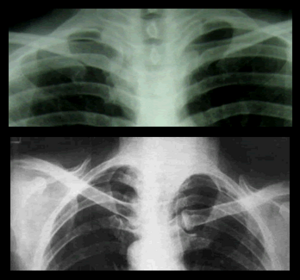Xray
Jump to navigation
Jump to search
No one ever teaches people how to read X-Rays. And we aren't going to either. That takes a lot of hard work, and you have to look at about a million xrays. What we can tell you, is how to present one, and sound like you know what you are talking about.
The case
- Who - Bloggs, Joe. Date of Birth: 22/04/1946
- When - Taken Tuesday 18th March
- Where - Downstairs in the A&E department
- What - Its a Chest Xray...
- How - ...and its PA
- Why - It was taken because we were worried he had pneumonia
How and why can be difficult. PA means Posterior Anterior, which is the direction the xrays travel through the back to the front. AP means Anterior Posterior, where the plate is at the back, and the rays travel through the front to the back. Why is something to include only if you know why. Don't guess.
The quality
You would say "The xray is well penetrated, not rotated and the patient is adequated inflated".
- Penetration - Is the plate had too much juice, or not enough. There are two ways to ensure this, is the trachea visible, and can individual vertebrae be clearly seen. Above right is a sample. The top section is well penetrated (note the trachea, and vertebrae), middle is under penetrated and the bottom over penetrated.
- Rotation - Has the patient been laying straight on when the plate was captured. Often in paediatrics they are off. There are several way to check this, but the main two are: can the bit where the ribs join the spine be seen more on one side than the other; and the the ends of the clavicles equal on each side. In the example on the right, you can see that in the top one, the clavicles are roughly equally visible. In the lower one, the body is clearly turned to the left.
- Inflation - The patient must have inhaled to ensure there is air in the chest. The way you ensure this is to count the number of posterior ribs you can see. More than 7-9 means the patient is adequately expanded. I don't have a picture for this.
The xray
- Tubes - Can you see any NG tubes or central lines, etc.
- Soft Tissues - Any obvious tissue abnormalities such as scars.
- Bones -
- Heart
- Lungs
- Abnormalities


